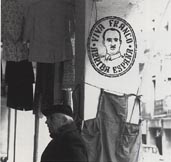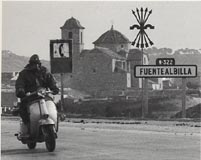|
In
1948, Catalá-Roca sets up indepently of his father and
opens his own studio and photographic laboratory. He did first
works that his father didn't do. Slowly he had his own customers.
He made a lot of fotos about Barcelona and Madrid.
|
In
Catalonia:
|
|
"Via
Laietana", Barcelona 1948.
Police
patrol throught Via Laietana in Barcelona, one of the most important
Barcelona's street, that leads direct to the sea, near the Barcelona's
Cathedral.
|
|
|
"Visit
of the Barrio Chino", Barcelona 1948.
The
arribal of the sailors in Barcelona. They went to Barrio Chino
to find bichs.
|
|
|
"Gipsy
girl", Barcelona, 1950.
A typical
gipsy girl, playing in a poor zone in Barcelona.
|
|
|
"Cadaqués",
1953.
A cat
in front of a boat in Cadaqués' beach in Cap de Creus.
|
|
|
"Fisherman",
l'Estartit 1953.
A fisherman
doing a basket for fishing.
|
|
|
"Marine",
Barcelona, 1953. |
|
|
"Roses",
1954.
Beach
of Roses, with baskets that fishermen take to fish the fish.
|
In
Madrid:
|
|
"Young
ladies strolling in the Gran Vía", Madrid, 1952.
Young
ladies walking in the Gran Vía the most famous street in
Madrid.
|
|
|
"Water
Vendor", Madrid, 1954.
A boy
sold water to the people with a pitcher that mantains the water
fresh.
|
|
|
"Plaza
del Oriente", Madrid, 1957.
Image
of the square of Oriente with two nuns.
|
|


















